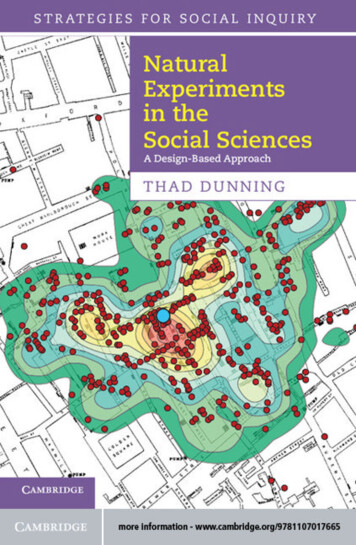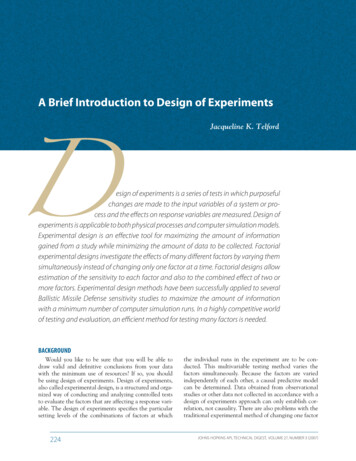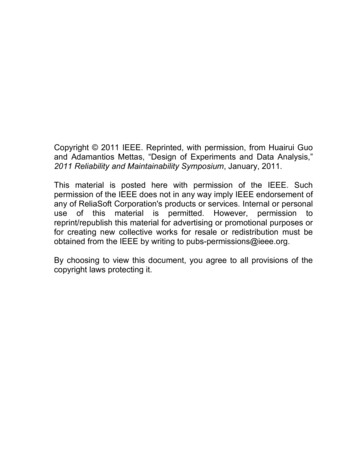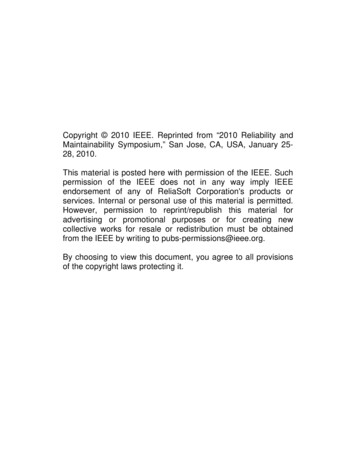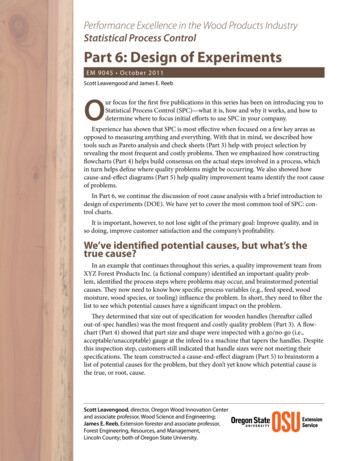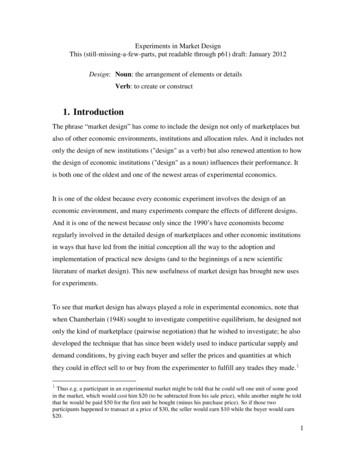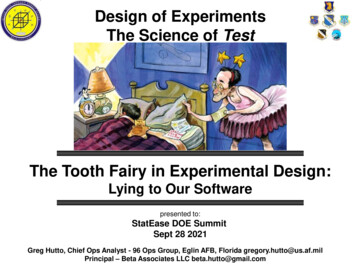
Transcription
Design and Analysisof ExperimentsEighth EditionDOUGLAS C. MONTGOMERYArizona State UniversityJohn Wiley & Sons, Inc.
VICE PRESIDENT AND PUBLISHERACQUISITIONS EDITORCONTENT MANAGERPRODUCTION EDITORMARKETING MANAGERDESIGN DIRECTORSENIOR DESIGNEREDITORIAL ASSISTANTPRODUCTION SERVICESCOVER PHOTOCOVER DESIGNDonald FowleyLinda RattsLucille BuonocoreAnna MelhornChristopher RuelHarry NolanMaureen EideChristopher TejaNamit Grover/Thomson DigitalNik Wheeler/Corbis ImagesWendy LaiThis book was set in Times by Thomson Digital and printed and bound by Courier Westford.The cover was printed by Courier Westford.This book is printed on acid-free paper. 앝Founded in 1807, John Wiley & Sons, Inc. has been a valued source of knowledge and understanding for morethan 200 years, helping people around the world meet their needs and fulfill their aspirations. Our company is builton a foundation of principles that include responsibility to the communities we serve and where we live and work.In 2008, we launched a Corporate Citizenship Initiative, a global effort to address the environmental, social,economic, and ethical challenges we face in our business. Among the issues we are addressing are carbon impact,paper specifications and procurement, ethical conduct within our business and among our vendors, and communityand charitable support. For more information, please visit our website: www.wiley.com/go/citizenship.Copyright 2013, 2009, 2005, 2001, 1997 John Wiley & Sons, Inc. All rights reserved. No part of this publicationmay be reproduced, stored in a retrieval system or transmitted in any form or by any means, electronic, mechanical,photocopying, recording, scanning or otherwise, except as permitted under Sections 107 or 108 of the 1976United States Copyright Act, without either the prior written permission of the Publisher, or authorization throughpayment of the appropriate per-copy fee to the Copyright Clearance Center, Inc., 222 Rosewood Drive, Danvers,MA 01923, website www.copyright.com. Requests to the Publisher for permission should be addressed to thePermissions Department, John Wiley & Sons, Inc., 111 River Street, Hoboken, NJ 07030-5774, (201) 748-6011,fax (201) 748-6008, website www.wiley.com/go/permissions.Evaluation copies are provided to qualified academics and professionals for review purposes only, for use in theircourses during the next academic year. These copies are licensed and may not be sold or transferred to a thirdparty. Upon completion of the review period, please return the evaluation copy to Wiley. Return instructions and afree of charge return shipping label are available at www.wiley.com/go/returnlabel. Outside of the United States,please contact your local representative.To order books or for customer service, please call 1-800-CALL WILEY (225-5945).Library of Congress Cataloging-in-Publication Data:Montgomery, Douglas C.Design and analysis of experiments / Douglas C. Montgomery. — Eighth edition.pages cmIncludes bibliographical references and index.ISBN 978-1-118-14692-71. Experimental design. I. Title.QA279.M66 2013519.5'7—dc232012000877ISBN 978-1118-14692-710 9 8 7 6 5 4 3 2 1
PrefaceAudienceThis is an introductory textbook dealing with the design and analysis of experiments. It is basedon college-level courses in design of experiments that I have taught over nearly 40 years atArizona State University, the University of Washington, and the Georgia Institute of Technology.It also reflects the methods that I have found useful in my own professional practice as an engineering and statistical consultant in many areas of science and engineering, including the researchand development activities required for successful technology commercialization and productrealization.The book is intended for students who have completed a first course in statistical methods. This background course should include at least some techniques of descriptive statistics,the standard sampling distributions, and an introduction to basic concepts of confidenceintervals and hypothesis testing for means and variances. Chapters 10, 11, and 12 requiresome familiarity with matrix algebra.Because the prerequisites are relatively modest, this book can be used in a second courseon statistics focusing on statistical design of experiments for undergraduate students in engineering, the physical and chemical sciences, statistics, mathematics, and other fields of science.For many years I have taught a course from the book at the first-year graduate level in engineering. Students in this course come from all of the fields of engineering, materials science,physics, chemistry, mathematics, operations research life sciences, and statistics. I have alsoused this book as the basis of an industrial short course on design of experiments for practicing technical professionals with a wide variety of backgrounds. There are numerous examplesillustrating all of the design and analysis techniques. These examples are based on real-worldapplications of experimental design and are drawn from many different fields of engineering andthe sciences. This adds a strong applications flavor to an academic course for engineersand scientists and makes the book useful as a reference tool for experimenters in a varietyof disciplines.v
viPrefaceAbout the BookThe eighth edition is a major revision of the book. I have tried to maintain the balancebetween design and analysis topics of previous editions; however, there are many new topicsand examples, and I have reorganized much of the material. There is much more emphasis onthe computer in this edition.Design-Expert, JMP, and Minitab SoftwareDuring the last few years a number of excellent software products to assist experimenters inboth the design and analysis phases of this subject have appeared. I have included output fromthree of these products, Design-Expert, JMP, and Minitab at many points in the text. Minitaband JMP are widely available general-purpose statistical software packages that have gooddata analysis capabilities and that handles the analysis of experiments with both fixed and random factors (including the mixed model). Design-Expert is a package focused exclusively onexperimental design. All three of these packages have many capabilities for construction andevaluation of designs and extensive analysis features. Student versions of Design-Expert andJMP are available as a packaging option with this book, and their use is highly recommended. I urge all instructors who use this book to incorporate computer software into yourcourse. (In my course, I bring a laptop computer and use a computer projector in everylecture, and every design or analysis topic discussed in class is illustrated with the computer.)To request this book with the student version of JMP or Design-Expert included, contactyour local Wiley representative. You can find your local Wiley representative by going towww.wiley.com/college and clicking on the tab for “Who’s My Rep?”Empirical ModelI have continued to focus on the connection between the experiment and the model thatthe experimenter can develop from the results of the experiment. Engineers (and physical,chemical and life scientists to a large extent) learn about physical mechanisms and theirunderlying mechanistic models early in their academic training, and throughout much oftheir professional careers they are involved with manipulation of these models.Statistically designed experiments offer the engineer a valid basis for developing anempirical model of the system being investigated. This empirical model can then bemanipulated (perhaps through a response surface or contour plot, or perhaps mathematically) just as any other engineering model. I have discovered through many years of teachingthat this viewpoint is very effective in creating enthusiasm in the engineering communityfor statistically designed experiments. Therefore, the notion of an underlying empiricalmodel for the experiment and response surfaces appears early in the book and receivesmuch more emphasis.Factorial DesignsI have expanded the material on factorial and fractional factorial designs (Chapters 5 – 9) inan effort to make the material flow more effectively from both the reader’s and the instructor’s viewpoint and to place more emphasis on the empirical model. There is new materialon a number of important topics, including follow-up experimentation following a fractionalfactorial, nonregular and nonorthogonal designs, and small, efficient resolution IV and Vdesigns. Nonregular fractions as alternatives to traditional minimum aberration fractions in16 runs and analysis methods for these design are discussed and illustrated.
PrefaceviiAdditional Important ChangesI have added a lot of material on optimal designs and their application. The chapter on responsesurfaces (Chapter 11) has several new topics and problems. I have expanded Chapter 12 onrobust parameter design and process robustness experiments. Chapters 13 and 14 discussexperiments involving random effects and some applications of these concepts to nested andsplit-plot designs. The residual maximum likelihood method is now widely available in software and I have emphasized this technique throughout the book. Because there is expandingindustrial interest in nested and split-plot designs, Chapters 13 and 14 have several new topics.Chapter 15 is an overview of important design and analysis topics: nonnormality of theresponse, the Box – Cox method for selecting the form of a transformation, and other alternatives; unbalanced factorial experiments; the analysis of covariance, including covariates in afactorial design, and repeated measures. I have also added new examples and problems fromvarious fields, including biochemistry and biotechnology.Experimental DesignThroughout the book I have stressed the importance of experimental design as a tool for engineers and scientists to use for product design and development as well as process development and improvement. The use of experimental design in developing products that are robustto environmental factors and other sources of variability is illustrated. I believe that the use ofexperimental design early in the product cycle can substantially reduce development lead timeand cost, leading to processes and products that perform better in the field and have higherreliability than those developed using other approaches.The book contains more material than can be covered comfortably in one course, and Ihope that instructors will be able to either vary the content of each course offering or discusssome topics in greater depth, depending on class interest. There are problem sets at the endof each chapter. These problems vary in scope from computational exercises, designed toreinforce the fundamentals, to extensions or elaboration of basic principles.Course SuggestionsMy own course focuses extensively on factorial and fractional factorial designs. Consequently,I usually cover Chapter 1, Chapter 2 (very quickly), most of Chapter 3, Chapter 4 (excludingthe material on incomplete blocks and only mentioning Latin squares briefly), and I discussChapters 5 through 8 on factorials and two-level factorial and fractional factorial designs indetail. To conclude the course, I introduce response surface methodology (Chapter 11) and givean overview of random effects models (Chapter 13) and nested and split-plot designs (Chapter14). I always require the students to complete a term project that involves designing, conducting, and presenting the results of a statistically designed experiment. I require them to do thisin teams because this is the way that much industrial experimentation is conducted. They mustpresent the results of this project, both orally and in written form.The Supplemental Text MaterialFor the eighth edition I have prepared supplemental text material for each chapter of the book.Often, this supplemental material elaborates on topics that could not be discussed in greater detailin the book. I have also presented some subjects that do not appear directly in the book, but anintroduction to them could prove useful to some students and professional practitioners. Some ofthis material is at a higher mathematical level than the text. I realize that instructors use this book
viiiPrefacewith a wide array of audiences, and some more advanced design courses could possibly benefitfrom including several of the supplemental text material topics. This material is in electronic formon the World Wide Website for this book, located at www.wiley.com/college/montgomery.WebsiteCurrent supporting material for instructors and students is available at the websitewww.wiley.com/college/montgomery. This site will be used to communicate informationabout innovations and recommendations for effectively using this text. The supplemental textmaterial described above is available at the site, along with electronic versions of data setsused for examples and homework problems, a course syllabus, and some representative student term projects from the course at Arizona State University.Student Companion SiteThe student’s section of the textbook website contains the following:1. The supplemental text material described above2. Data sets from the book examples and homework problems, in electronic form3. Sample Student ProjectsInstructor Companion SiteThe instructor’s section of the textbook website contains the following:4.5.6.7.8.9.10.Solutions to the text problemsThe supplemental text material described abovePowerPoint lecture slidesFigures from the text in electronic format, for easy inclusion in lecture slidesData sets from the book examples and homework problems, in electronic formSample SyllabusSample Student ProjectsThe instructor’s section is for instructor use only, and is password-protected. Visit theInstructor Companion Site portion of the website, located at www.wiley.com/college/montgomery, to register for a password.Student Solutions ManualThe purpose of the Student Solutions Manual is to provide the student with an in-depth understanding of how to apply the concepts presented in the textbook. Along with detailed instructions on how to solve the selected chapter exercises, insights from practical applications arealso shared.Solutions have been provided for problems selected by the author of the text.Occasionally a group of “continued exercises” is presented and provides the student with afull solution for a specific data set. Problems that are included in the Student SolutionsManual are indicated by an icon appearing in the text margin next to the problem statement.This is an excellent study aid that many text users will find extremely helpful. TheStudent Solutions Manual may be ordered in a set with the text, or purchased separately.Contact your local Wiley representative to request the set for your bookstore, or purchase theStudent Solutions Manual from the Wiley website.
PrefaceixAcknowledgmentsI express my appreciation to the many students, instructors, and colleagues who have used the sixearlier editions of this book and who have made helpful suggestions for its revision. The contributions of Dr. Raymond H. Myers, Dr. G. Geoffrey Vining, Dr. Brad Jones,Dr. Christine Anderson-Cook, Dr. Connie M. Borror, Dr. Scott Kowalski, Dr. Dennis Lin,Dr. John Ramberg, Dr. Joseph Pignatiello, Dr. Lloyd S. Nelson, Dr. Andre Khuri, Dr. PeterNelson, Dr. John A. Cornell, Dr. Saeed Maghsoodlo, Dr. Don Holcomb, Dr. George C. Runger,Dr. Bert Keats, Dr. Dwayne Rollier, Dr. Norma Hubele, Dr. Murat Kulahci, Dr. Cynthia Lowry,Dr. Russell G. Heikes, Dr. Harrison M. Wadsworth, Dr. William W. Hines, Dr. Arvind Shah,Dr. Jane Ammons, Dr. Diane Schaub, Mr. Mark Anderson, Mr. Pat Whitcomb, Dr. Pat Spagon,and Dr. William DuMouche were particularly valuable. My current and former DepartmentChairs, Dr. Ron Askin and Dr. Gary Hogg, have provided an intellectually stimulating environment in which to work.The contributions of the professional practitioners with whom I have worked have beeninvaluable. It is impossible to mention everyone, but some of the major contributors includeDr. Dan McCarville of Mindspeed Corporation, Dr. Lisa Custer of the George Group;Dr. Richard Post of Intel; Mr. Tom Bingham, Mr. Dick Vaughn, Dr. Julian Anderson,Mr. Richard Alkire, and Mr. Chase Neilson of the Boeing Company; Mr. Mike Goza, Mr. DonWalton, Ms. Karen Madison, Mr. Jeff Stevens, and Mr. Bob Kohm of Alcoa; Dr. Jay Gardiner,Mr. John Butora, Mr. Dana Lesher, Mr. Lolly Marwah, Mr. Leon Mason of IBM; Dr. PaulTobias of IBM and Sematech; Ms. Elizabeth A. Peck of The Coca-Cola Company; Dr. SadriKhalessi and Mr. Franz Wagner of Signetics; Mr. Robert V. Baxley of Monsanto Chemicals;Mr. Harry Peterson-Nedry and Dr. Russell Boyles of Precision Castparts Corporation;Mr. Bill New and Mr. Randy Schmid of Allied-Signal Aerospace; Mr. John M. Fluke, Jr. ofthe John Fluke Manufacturing Company; Mr. Larry Newton and Mr. Kip Howlett of GeorgiaPacific; and Dr. Ernesto Ramos of BBN Software Products Corporation.I am indebted to Professor E. S. Pearson and the Biometrika Trustees, John Wiley &Sons, Prentice Hall, The American Statistical Association, The Institute of MathematicalStatistics, and the editors of Biometrics for permission to use copyrighted material. Dr. LisaCuster and Dr. Dan McCorville did an excellent job of preparing the solutions that appear inthe Instructor’s Solutions Manual, and Dr. Cheryl Jennings and Dr. Sarah Streett providedeffective and very helpful proofreading assistance. I am grateful to NASA, the Office ofNaval Research, the National Science Foundation, the member companies of theNSF/Industry/University Cooperative Research Center in Quality and Reliability Engineeringat Arizona State University, and the IBM Corporation for supporting much of my researchin engineering statistics and experimental design.DOUGLAS C. MONTGOMERYTEMPE, ARIZONA
7181114212223Strategy of ExperimentationSome Typical Applications of Experimental DesignBasic PrinciplesGuidelines for Designing ExperimentsA Brief History of Statistical DesignSummary: Using Statistical Techniques in ExperimentationProblems2Simple Comparative c Statistical ConceptsSampling and Sampling DistributionsInferences About the Differences in Means, Randomized 36434448505051Hypothesis TestingConfidence IntervalsChoice of Sample SizeThe Case Where 21 Z 22The Case Where 21 and 22 Are KnownComparing a Single Mean to a Specified ValueSummaryInferences About the Differences in Means, Paired Comparison Designs532.5.12.5.2The Paired Comparison ProblemAdvantages of the Paired Comparison Design5356Inferences About the Variances of Normal DistributionsProblems5759xi
xiiContents3Experiments with a Single Factor:The Analysis of Variance3.13.23.33.43.5An ExampleThe Analysis of VarianceAnalysis of the Fixed Effects position of the Total Sum of SquaresStatistical AnalysisEstimation of the Model ParametersUnbalanced DataModel Adequacy Checking803.4.13.4.23.4.33.4.480828388The Normality AssumptionPlot of Residuals in Time SequencePlot of Residuals Versus Fitted ValuesPlots of Residuals Versus Other VariablesPractical Interpretation of 3.765A Regression ModelComparisons Among Treatment MeansGraphical Comparisons of MeansContrastsOrthogonal ContrastsScheffé’s Method for Comparing All ContrastsComparing Pairs of Treatment MeansComparing Treatment Means with a Control8989909192949697101Sample Computer OutputDetermining Sample Size1021053.7.13.7.23.7.3105108109Operating Characteristic CurvesSpecifying a Standard Deviation IncreaseConfidence Interval Estimation MethodOther Examples of Single-Factor Experiments1103.8.13.8.23.8.3110110114Chocolate and Cardiovascular HealthA Real Economy Application of a Designed ExperimentDiscovering Dispersion EffectsThe Random Effects Model1163.9.13.9.23.9.3116117118A Single Random FactorAnalysis of Variance for the Random ModelEstimating the Model Parameters3.10 The Regression Approach to the Analysis of Variance1253.10.1 Least Squares Estimation of the Model Parameters3.10.2 The General Regression Significance Test1251263.11 Nonparametric Methods in the Analysis of Variance3.11.1 The Kruskal–Wallis Test3.11.2 General Comments on the Rank Transformation3.12 Problems1281281301304Randomized Blocks, Latin Squares,and Related Designs4 . 1 The Randomized Complete Block Design4.1.14.1.2Statistical Analysis of the RCBDModel Adequacy Checking139139141149
Contents4.1.34.1.44.24.34.44.5Some Other Aspects of the Randomized Complete Block DesignEstimating Model Parameters and the General RegressionSignificance Test4.4.14.4.24.4.3168172174177Statistical Analysis of the BIBDLeast Squares Estimation of the ParametersRecovery of Interblock Information in the BIBDProblems183Basic Definitions and PrinciplesThe Advantage of FactorialsThe Two-Factor Factorial 187189198198201202203An ExampleStatistical Analysis of the Fixed Effects ModelModel Adequacy CheckingEstimating the Model ParametersChoice of Sample SizeThe Assumption of No Interaction in a Two-Factor ModelOne Observation per CellThe General Factorial DesignFitting Response Curves and SurfacesBlocking in a Factorial DesignProblems6The 2k Factorial ntroduction to Factorial Designs5.45.55.65.7150The Latin Square DesignThe Graeco-Latin Square DesignBalanced Incomplete Block Designs55.15.25.3xiiiIntroductionThe 22 DesignThe 23 DesignThe General 2k DesignA Single Replicate of the 2k DesignAdditional Examples of Unreplicated 2k Design2k Designs are Optimal DesignsThe Addition of Center Points to the 2k DesignWhy We Work with Coded Design 2802852902927Blocking and Confounding in the 2kFactorial Design7.17.27.3IntroductionBlocking a Replicated 2k Factorial DesignConfounding in the 2k Factorial Design304304305306
xivContents7.47.57.67.77.87.9Confounding the 2k Factorial Design in Two BlocksAnother Illustration of Why Blocking Is ImportantConfounding the 2k Factorial Design in Four BlocksConfounding the 2k Factorial Design in 2p BlocksPartial ConfoundingProblems8Two-Level Fractional Factorial Designs8.18.28.38.48.58.6320IntroductionThe One-Half Fraction of the 2k Design3203218.2.18.2.28.2.3321323324Definitions and Basic PrinciplesDesign ResolutionConstruction and Analysis of the One-Half FractionThe One-Quarter Fraction of the 2k DesignThe General 2k p Fractional Factorial Design3333408.4.18.4.28.4.3340343344Choosing a DesignAnalysis of 2k p Fractional FactorialsBlocking Fractional FactorialsAlias Structures in Fractional Factorialsand other DesignsResolution III Designs8.6.18.6.2Constructing Resolution III DesignsFold Over of Resolution III Fractions toSeparate Aliased EffectsPlackett-Burman solution IV and V Designs3668.7.18.7.28.7.3366367373Resolution IV DesignsSequential Experimentation with Resolution IV DesignsResolution V Designs8.8 Supersaturated Designs8.9 Summary8.10 Problems3743753769Additional Design and Analysis Topics for Factorialand Fractional Factorial Designs9.1kThe 3 Factorial Design9.1.19.1.29.1.39.1.49.2Confounding in the 3k Factorial Design9.2.19.2.29.2.39.3Notation and Motivation for the 3k DesignThe 32 DesignThe 33 DesignThe General 3k DesignThe 3k Factorial Design in Three BlocksThe 3k Factorial Design in Nine BlocksThe 3k Factorial Design in 3p BlocksFractional Replication of the 3k Factorial Design9.3.19.3.2The One-Third Fraction of the 3k Factorial DesignOther 3k p Fractional Factorial Designs394395395396397402402403406407408408410
Contents9.49.59.69.7Factorials with Mixed Levels4129.4.19.4.2412414Factors at Two and Three LevelsFactors at Two and Four LevelsNonregular Fractional Factorial Designs4159.5.1 Nonregular Fractional Factorial Designs for 6, 7, and 8 Factors in 16 Runs9.5.2 Nonregular Fractional Factorial Designs for 9 Through 14 Factors in 16 Runs9.5.3 Analysis of Nonregular Fractional Factorial Designs418425427Constructing Factorial and Fractional Factorial Designs Usingan Optimal Design Tool4319.6.19.6.29.6.3433433443Design Optimality CriteriaExamples of Optimal DesignsExtensions of the Optimal Design ApproachProblems10Fitting Regression Models10.110.210.310.4444449IntroductionLinear Regression ModelsEstimation of the Parameters in Linear Regression ModelsHypothesis Testing in Multiple Regression44945045146210.4.1 Test for Significance of Regression10.4.2 Tests on Individual Regression Coefficients and Groups of Coefficients46246410.5 Confidence Intervals in Multiple Regression10.5.1 Confidence Intervals on the Individual Regression Coefficients10.5.2 Confidence Interval on the Mean Response10.6 Prediction of New Response Observations10.7 Regression Model Diagnostics10.7.1 Scaled Residuals and PRESS10.7.2 Influence Diagnostics10.8 Testing for Lack of Fit10.9 Problems11Response Surface Methods and Designs11.1 Introduction to Response Surface Methodology11.2 The Method of Steepest Ascent11.3 Analysis of a Second-Order Response Surface11.3.111.3.211.3.311.3.4Location of the Stationary PointCharacterizing the Response SurfaceRidge SystemsMultiple Responses11.4 Experimental Designs for Fitting Response Designs for Fitting the First-Order ModelDesigns for Fitting the Second-Order ModelBlocking in Response Surface DesignsOptimal Designs for Response SurfacesExperiments with Computer ModelsMixture ExperimentsEvolutionary 480486486488495496500501501507511523530540544
xviContents12Robust Parameter Design and ProcessRobustness Studies12.112.212.312.4IntroductionCrossed Array DesignsAnalysis of the Crossed Array DesignCombined Array Designs and the ResponseModel Approach12.5 Choice of Designs12.6 Problems13Experiments with Random 570573Random Effects ModelsThe Two-Factor Factorial with Random FactorsThe Two-Factor Mixed ModelSample Size Determination with Random EffectsRules for Expected Mean SquaresApproximate F TestsSome Additional Topics on Estimation of Variance Components57357458158758859259613.7.1 Approximate Confidence Intervals on Variance Components13.7.2 The Modified Large-Sample Method59760013.8 Problems14Nested and Split-Plot Designs14.1 The Two-Stage Nested tatistical AnalysisDiagnostic CheckingVariance ComponentsStaggered Nested Designs601604604605609611612The General m-Stage Nested DesignDesigns with Both Nested and Factorial FactorsThe Split-Plot DesignOther Variations of the Split-Plot Design61461662162714.5.1 Split-Plot Designs with More Than Two Factors14.5.2 The Split-Split-Plot Design14.5.3 The Strip-Split-Plot Design62763263614.6 Problems15Other Design and Analysis Topics15.1 Nonnormal Responses and Transformations15.1.1 Selecting a Transformation: The Box–Cox Method15.1.2 The Generalized Linear Model637642643643645
Contents15.2 Unbalanced Data in a Factorial Design15.2.1 Proportional Data: An Easy Case15.2.2 Approximate Methods15.2.3 The Exact Method15.3 The Analysis of Covariance15.3.115.3.215.3.315.3.4Description of the ProcedureComputer SolutionDevelopment by the General Regression Significance TestFactorial Experiments with Covariates15.4 Repeated Measures15.5 ProblemsAppendixTable I.Table II.Table III.Table IV.Table V.Table VI.Table VII.Table VIII.Table IX.Table ve Standard Normal DistributionPercentage Points of the t DistributionPercentage Points of the 2 DistributionPercentage Points of the F DistributionOperating Characteristic Curves for the Fixed Effects ModelAnalysis of VarianceOperating Characteristic Curves for the Random Effects ModelAnalysis of VariancePercentage Points of the Studentized Range StatisticCritical Values for Dunnett’s Test for Comparing Treatmentswith a ControlCoefficients of Orthogonal PolynomialsAlias Relationships for 2k p Fractional Factorial Designs with k 15and n ex725
C H A P T E R1IntroductionCHAPTER OUTLINE1.1 STRATEGY OF EXPERIMENTATION1.2 SOME TYPICAL APPLICATIONSOF EXPERIMENTAL DESIGN1.3 BASIC PRINCIPLES1.4 GUIDELINES FOR DESIGNING EXPERIMENTS1.5 A BRIEF HISTORY OF STATISTICAL DESIGN1.6 SUMMARY: USING STATISTICAL TECHNIQUESIN EXPERIMENTATIONSUPPLEMENTAL MATERIAL FOR CHAPTER 1S1.1 More about Planning ExperimentsS1.2 Blank Guide Sheets to Assist in Pre-ExperimentalPlanningS1.3 Montgomery’s Theorems on Designed ExperimentsThe supplemental material is on the textbook website www.wiley.com/college/montgomery.1.1Strategy of ExperimentationObserving a system or process while it is in operation is an important part of the learningprocess, and is an integral part of understanding and learning about how systems andprocesses work. The great New York Yankees catcher Yogi Berra said that “. . . you canobserve a lot just by watching.” However, to understand what happens to a process whenyou change certain input factors, you have to do more than just watch—you actually haveto change the factors. This means that to really understand cause-and-effect relationships ina system you must deliberately change the input variables to the system and observe thechanges in the system output that these changes to the inputs produce. In other words, youneed to conduct experiments on the system. Observations on a system or process can leadto theories or hypotheses about what makes the system work, but experiments of the typedescribed above are required to demonstrate that these theories are correct.Investigators perform experiments in virtually all fields of inquiry, usually to dis
Montgomery, Douglas C. Design and analysis of experiments / Douglas C. Montgomery. — Eighth edition. pages cm Includes bibliographical references and index. ISBN 978-1-118-14692-7 1. Experimental design. I. Title. QA279.M66 2013 519.5'7—d
